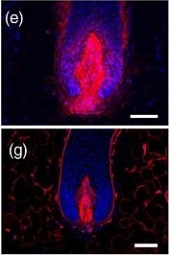I have covered Dr. Maksim Plikus a few times on this blog in the past. I have also discussed Hedgehog signaling and hair growth in detail. Yesterday, a University of California team (led by Dr. Plikus) discovered a critical signaling molecule SCUBE3 that stimulates hair growth.
Update: March 27, 2023
In a new interview with UCI, Dr. Plikus states that:
“SCUBE3 would be microinjected less than a millimeter beneath a person’s skin. It would be a fairly painless process that would have to be repeated periodically to maintain hair growth.”
Update: July 29, 2022
Yet another update just came out (h/t “YoYo”). I like the phrase “digitize the hair“.
Update: July 18, 2022
New video titled: “UC Irvine scientists discover a possible cure for baldness.” Starring Dr. Maksim Plikus (h/t “YoYo”). And yet another one.
Update: July 7, 2022
Dr. William Rassman provided an update on Reddit on July 7:

SCUBE3 represents one part of the interconnected hair growth loop that also includes the hedgehog pathway, dermal papilla cells, TGF-β and Wnt5a. This interaction is shown in the below diagram from this latest research.

July 1, 2022
SCUBE3 Signaling Molecule Stimulates Hair Growth
University of California, Irvine (UCI) led researchers have discovered that a signaling molecule (which they call SCUBE3) potently stimulates hair growth. Most importantly, it may offer a therapeutic treatment for androgenetic alopecia, which accounts for 90-95 percent of hair loss cases in both men and women.
The actual study was published yesterday in Development Cell. The study team included health professionals and academics from UCI, San Diego, China, Japan, Korea and Taiwan.
“UCI has filed a provisional patent application on the use of SCUBE3 and its related molecular compounds for hair growth stimulation.”
This study discovered the precise mechanism by which the dermal papilla cells (fibroblasts at the bottom of each hair follicle) promote new growth. According to Dr. Plikus:
“We revealed that the SCUBE3 signaling molecule, which dermal papilla cells produce naturally, is the messenger used to ‘tell’ the neighboring hair stem cells to start dividing, which heralds the onset of new hair growth.”
In people with androgenetic alopecia, dermal papilla cells start to malfunction. One of the reasons behind this is a major reduction in the normally abundant signaling and activating molecules. It seems like SCUBE3 protein microinjections are sufficient to induce new hair growth.
However, note that mice were involved in this initial work. The research team microinjected SCUBE3 into mouse skin in which human scalp follicles had been transplanted. This induced new growth in both the dormant human hair follicles and surrounding mouse follicles due to “hyperactivated” dermal papilla cells.
Per co-first author and UCI postdoctoral researcher Christian Guerrero-Juarez, these experiments provide proof that SCUBE3 or derived molecules can be a promising therapeutic for hair loss.
According to Dr. Plikus, there is a strong need for new, effective hair loss medications. Naturally occurring compounds that are used by dermal papilla cells for hair growth “present ideal next-generation” candidates for pattern baldness treatment.
More detailed research on this subject will be conducted in the Plikus Lab and at Amplifica Holdings Group. The latter is a biotechnology company that was co-founded by Plikus and includes Dr. William Rassman on its team. For more on that company, see my post on Amplifica and its hairy moles treatment for baldness.

